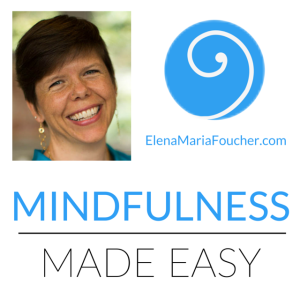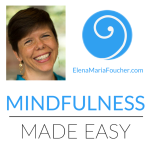 (meditation: 5:14 min) This practice is a classic mindfulness practice that is very old. In this practice we focus on the sounds around us. Some people love this practice. It is like a breath of fresh air. Whew! Finally, a practice that I like!
(meditation: 5:14 min) This practice is a classic mindfulness practice that is very old. In this practice we focus on the sounds around us. Some people love this practice. It is like a breath of fresh air. Whew! Finally, a practice that I like!
And other people really don’t like it.
This is why I offer it, because I find that we’re all different in what we like and don’t like and the best practice is one that you like! Why? Because you are more likely to do it if you like it!
Try this out and see what you feel. You may find that this is the one for you! And if you like this kind of practice, there are lots of other practices out in the world that focus on sound for you to try.
Enjoy!
Mindfulness Practice: River of Sound
- Begin by getting into position, whatever position works best for your body. I suggest the following:
- Sit on a chair (sofa, bed, etc) with your feet flat on the floor.
- Rest your hands, palms down, on your thighs.
- Feel your sit bones pressing down.
- Float the crown of your head up so that it softly lifts your torso.
- Tuck your chin in a bit so that the back of your neck is soft and long.
- Soften your jaw.
- Let your front body be soft (relax your belly, chest and face) and your back body be firm and upright.
- Close your eyes.
- Bring your attention to your breath. Notice how it feels to breathe.
- Gently shift your attention to what you can hear.
- Imagine that you are a rock in the middle of a river. A river of sound.
- Notice the whole river of sound as it floats by. Don’t focus on a particular sound, rather soften your hearing and listen to all of the sounds. Listen to the whole river of sound as it flows by.
- Keep most of your attention here as much as you can. Let everything else float by in the background. Let thoughts, emotions and physical sensations flow through like an undercurrent.
- If you find that your attention has become absorbed in your thoughts (emotions or sensations) to the point that you are no longer noticing the river of sound, simply let the thoughts go, and kindly and gently bring your attention back to the river and start a fresh. You can have an infinite number of fresh starts, so you can relax about that.
- End the practice when you feel ready or when your timer rings by gently opening your eyes.
To Download:
Click on the Download button below.
If it does not download automatically:
- A new window will open with an audio player (like the player above).
- Right click on the player and choose “Download File” or “Download Video”
- iPhone users will want to first copy the meditation into iTunes (on your computer) and then sync with your iPhone.
Note that you are welcome to download and share this files as many times as you like provided you do so in it’s entirety and it is used for personal or educational use only (no commercial uses).

 (meditation: 5:27 min) You may be familiar with body scan meditatons from your yoga class, Vipissana meditation or other modalities. You can find them in many different places and there are many ways to do them.
(meditation: 5:27 min) You may be familiar with body scan meditatons from your yoga class, Vipissana meditation or other modalities. You can find them in many different places and there are many ways to do them.